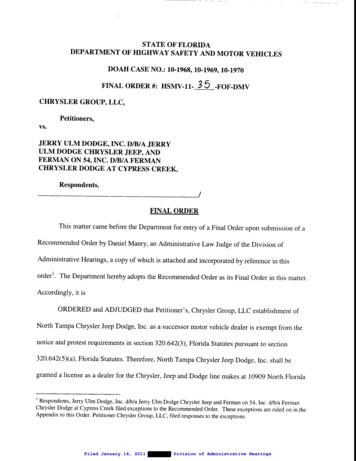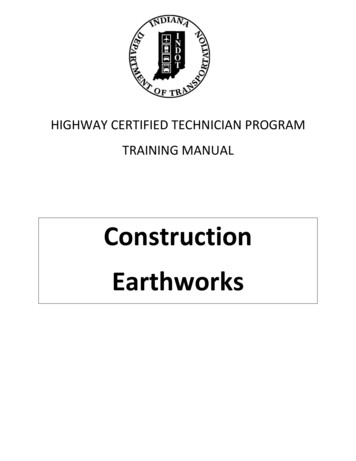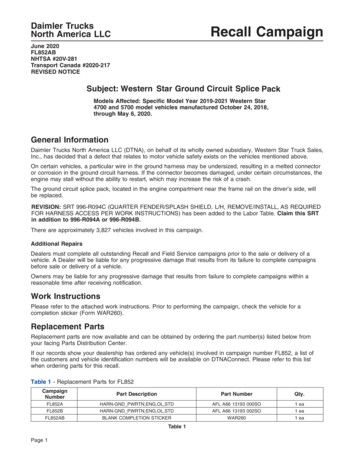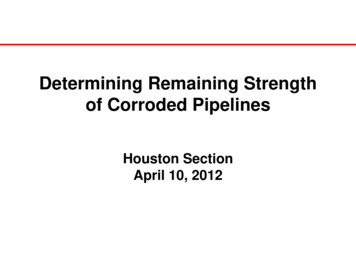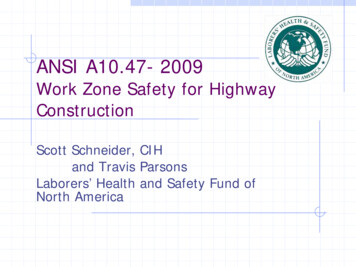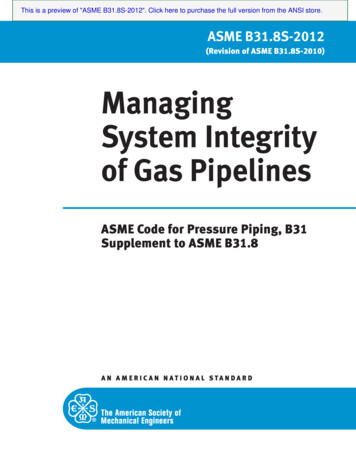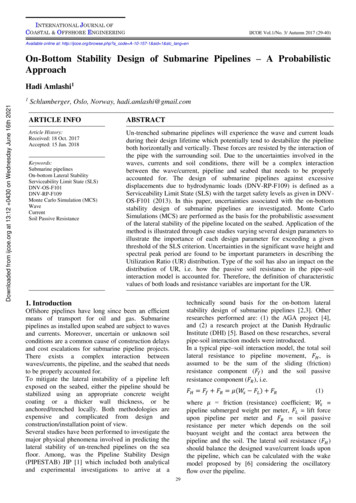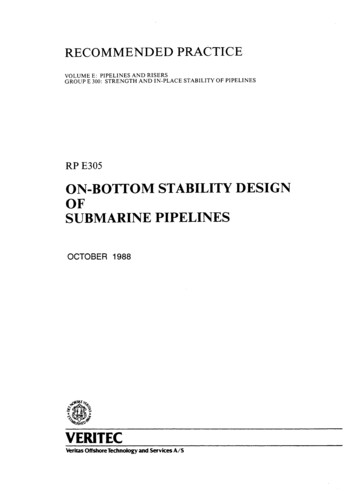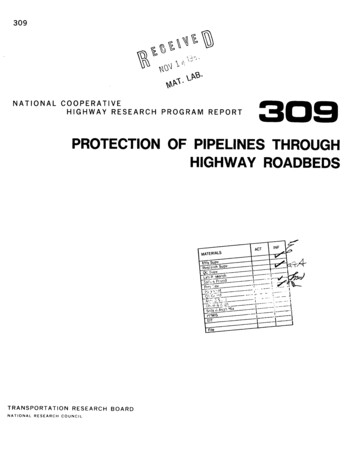
Transcription
309NATIONAL COOPERATIVEHIGHWAY RESEARCH PROGRAM REPORT309PROTECTION OF PIPELINES THROUGHHIGHWAY ROADBEDSACTINFMATERIALS- V ITRANSPORTATION RESEARCH BOARDNATIONAL RESEARCH COUNCIL
TRANSPORTATION RESEARCH BOARD EXECUTIVE COMMITTEE 1988OfficersChairmanHERBERT H. RICHARDSON, Deputy Chancellor and Dean of Engineering, Texas A&M University SystemVice ChairmanLOUIS J. GAMBACCINI, President, Institute of Public AdministrationSecretaryTHOMAS B. DEEN, Executive Director, Transportation Research BoardMembersALFRED A. DELLIBOVI, Urban Mass Transportation Administrator, U.S. Department of Transportation (ex officio)ROBERT E. FARRIS, Federal Highway Administration, Deputy Administrator, U.S. Department of Transportation (ex officio)FRANCIS B. FRANCOIS, Executive Director, American Association of State Highway and Transportation Officials (ex officio)JOHN GRAY, President, National Asphalt Pavement Association (ex officio)T. ALLAN McARTOR, Federal Aviation Administrator, US. Department of Transportation (ex officio)DIANE STEED, National Highway Traffic Safety Administrator, US. Department of Transportation (ex officio)GEORGE H. WAY, JR., Vice President. Research and Test Department, Association of American Railroads (ex officio)ROBERT N. BOTHMAN, Director, Oregon Department of TransportationJOHN A. CLEMENTS, Vice President, Parsons Brinckerhoff Quade and Douglas, Inc. (Past Chairman, 1985)DANA F. CONNORS, Commissioner, Maine Department of TransportationL. STANLEY CRANE, Chairman and Chief Executive Officer, Consolidated Rail Corporation, PhiladelphiaPAUL B. GAINES, Director of Aviation, City of Houston Aviation DepartmentWILLIAM J. HARRIS, E.B. Snead Distinguished Professor of Transportation Engineering, Department of Civil Engineering, Texas A&M UniversityE. R. HEIBERG III, Chief of Engineers and Commander, US. Army Corps of Engineer (ex officio)LESTER A. HOEL, Hamilton Professor and Chairman, Department of Civil Engineering, University of Virginia, (Past Chairman, 1986)THOMAS L. MAINWARING, Consultant, Trucking Industry Affairs, Ryder System, Inc.DENMAN K. McNEAR, Chairman, President and Chief Executive Officer, Southern Pacific Transportation CompanyLENO MENGHINI, Superintendent and Chief Engineer, Wyoming Highway DepartmentWILLIAM W. MILLAR, Executive Director, Port Authority of Allegheny CountyWAYNE MURI, Chief Engineer, Missouri Highway & Transportation CommissionROBERT E. PAASWELL, Executive Director, Chicago Transit AuthorityJAMES P. PITZ, Director, Michigan Department of TransportationJOE G. RIDEOUTTE, Executive Director, South Carolina Department of Highways and Public TransportationTED TEDESCO, Vice President, Resource Planning, American Airlines, Inc., Dallas/Fort Worth AirportCARMEN E. TURNER, General Manager, Washington Metropolitan Area Transit AuthorityFRANKLIN E. WHITE, Commissioner of Transportation, State of New York Department of TransportationJULIAN WOLPERT, Henry G. Bryant Professor of Geography, Public Affairs and Urban Planning, Woodrow Wilson School of Public and International Affairs, PrincetonUniversityCARL S. YOUNG, County Executive, Broome County, Binghamton, New YorkPAUL ZIA, Professor and Department Head, Department of Civil Engineering, North Carolina State UniversityNATIONAL COOPERATIVE HIGHWAY RESEARCH PROGRAMTransportation Research Board Executive Committee Subcommittee for NCHRPHERBERT H. RICHARDSON, Texas A&M University SystemLOUIS J. GAMBACCINI, Institute of Public AdministrationFRANCIS B. FRANCOIS, American Association of State Highway andROBERT E. FARRIS, US. Department of TransportationMILTON PIKARSKY, City College of New YorkTHOMAS B. DEEN, Transportation Research BoardTransportation OfficialsField of DesignArea of General DesignProject Panel C15-9JAMES H. ANDERSON, Minnegasco (Chairman)HARRY BOUCHER, CAL TRANSMICHAEL M. CHRISTENSEN, Minnesota Department of TransportationFRANK E. FULTON, U.S. Department of TransportationDAVID L. HOUCHIN, CSX TransportationDON H. JONES, University of TennesseeProgram StaffROBERT J. REILLY, Director, Cooperative Research ProgramsLOUIS M. MACGREGOR, Program OfficerDANIEL W. DEARASAUGH, JR., Senior Program OfficerIAN M. FRIEDLAND, Senior Program OfficerWENDEL T. RUFF, Mississi),pi State Highway DepartmentALBERT F. LAUBE, Virginia Department of Hwys. & Transp.KENNETH W. WALKER, Pennsylvania Department of TransportationRONALD L. WILLIAMS, West Virginia Department of HighwaysJERAR NISHANIAN, FHWA Liaison RepresentativeGEORGE W. RING III, TRB Liaison RepresentativeCRAWFORD F. JENCKS, Senior Program OfficerFRANK N. LISLE, Senior Program OfficerDAN A. ROSEN, Senior Program OfficerHELEN MACK, Editor
NATIONAL COOPERATIVE HIGHWAY RESEARCH PROGRAMRE PORT309PROTECTION OF PIPELINES THROUGHHIGHWAY ROADBEDSR. A. KOENIG JR. and J. P. TAYLOR,Wilbur Smith AssociatesFalls Church, VirginiaAREAS OF INTEREST:Facilities DesignMaintenanceSoil Foundations(Highway Transportation, Rail Transportation)TRANSPORTATION RESEARCH BOARDNATIONAL RESEARCH COUNCILWASHINGTON, D.C.JULY 1988RESEARCH SPONSORED BY THE AMERICANASSOCIATION OF STATE HIGHWAY ANDTRANSPORTATION OFFICIALS IN COOPERATIONWITH THE FEDERAL HIGHWAY ADMINISTRATION
NATIONAL COOPERATIVE HIGHWAY RESEARCHPROGRAMNCHRP REPORT 309Project 15-9 FY '85Systematic, well-designed research provides the most effective approach to the solution of many problems facing highway administrators and engineers. Often, highway problemsare of local interest and can best be studied by highway departments individually or in cooperation with their stateuniversities and others. However, the accelerating growthof highway transportation develops increasingly complexproblems of wide interest to highway authorities. Theseproblems are best studied through a coordinated program ofcooperative research.In recognition of these needs, the highway administrators ofthe American Association of State Highway and Transportation Officials initiated in 1962 an objective national highway research program employing modern scientific techniques. This program is supported on a continuing basis byfunds from participating member states of the Associationand it receives the full cooperation and support of the Federal Highway Administration, United States Department ofTransportation.The Transportation Research Board of the National Research Council was requested by the Association to administer the research program because of the Board'sTecognized objectivity and understanding of modern researchpractices. The Board is uniquely suited for this purpose as:it maintains an extensive committee structure from whichauthorities on any highway transportation subject may bedrawn; it possesses avenues of communications and cooperation with federal, state, and local governmental agencies,universities, and industry; its relationship to the NationalResearch Council is an insurance of objectivity; it maintainsa full-time research correlation staff of specialists in highway transportation matters to bring the findings of researchdirectly to those who are in a position to use them.The program is developed on the basis of research needsidentified by chief administrators of the highway and transportation departments and by committees of AASHTO.Each year, specific areas of research needs to be included inthe program are proposed to the National Research Counciland the Board by the American Association of State Highway and Transportation Officials. Research projects to fulfillthese needs are defined by the Board, and qualified researchagencies are selected from those that have submitted proposals. Administration and surveillance of research contractsare the responsibilities of the National Research Counciland the Transportation Research Board.The needs for highway research are many, and the NationalCooperative Highway Research Program can make significant contributions to the solution of highway transportationproblems of mutual concern to many responsible groups.The program, however, is intended to complement ratherthan to substitute for or duplicate other highway researchprograms.ISSN 0077-5614ISBN 0-309-04606-8L. C. Catalog Card No. 88-51016Price 8.00NOTICEThe project that is the subject of this report was a part of the National Cooperative Highway Research Program conducted by the Transportation Research Board with the approval of the (iovettslng Board of the NationalResearch Council. Such approval reflects the Governing Board's judgmentthat the program concerned is of national importance and appropriate withrespect to both the purposes and resources of the National Research Council.The members of the technical committee selected to monitor this project andto review this report were chosen for recognized scholarly competence andwith due consideration for the balance of disciplines appropriate to the project. The opinions and conclusions expressed or implied are those of the research agency that performed the research, and, while they have beenaccepted as appropriate by the technical committee, they are not necessarilythose of the Transportation Research Board, the National Research Council,the American Association of State Highway and Transportation officials, orthe Federal Highway Administration, U.S. Department of Transportation.Each report is reviewed and accepted for publication by the technical committee according to procedures established and monitored by the Transportation Research Board Executive Committee and the Governing Board of theNational Research Council.Special NoticeThe Transportation Research Board, the National Research Council, the Federal Highway Administration, the American Association of State Highwayand Transportation Officials, and the individual states participating in theNational Cooperative Highway Research Program do not endorse products ormanufacturers. Trade or manufacturers' names appear herein solely becausethey are considered essential to the object of this report.Published reports of theNATIONAL COOPERATIVE HIGHWAY RESEARCH PROGRAMare available from:Transportation Research BoardNational Research Council2101 Constitution Avenue, N.W.Washington, D.C. 20418Printed in the United States of America
FOREWORDBy StaffTransportationResearch BoardThis report provides a summary of information on protection of pipeline crossingsof highways and contains guidelines for use by highway officials in determining thedesired type of protection for specific circumstances. These guidelines take into accountfactors such as pipe location and design, construction methods, required cover, consequences of failure, corrosion protection, and future highway widening and construction. The guidelines may be used to assist states in formulating policies on pipelinecrossings. The report should be of interest to highway department personnel dealingwith utilities and right-of-way, as well as to individuals with utility companies whomust prepare requests for pipeline crossings.Existing policies for pipeline protection are extremely varied. Many state highwayand transportation agencies require that pipelines through highway roadbeds be encased. This policy is predicated on the expectation that as a result of encasement: (1)the pipeline is protected from associated loading; (2) in the event of pipeline rupture,liquids would be discharged out of the ends of the casing, protecting the integrity ofthe roadbed; and (3) ruptured pipelines could be conveniently removed from the casingand new pipe reinstalled. In other cases, improved pipe designs and strengths, togetherwith the problems and costs of the use of casings with cathodic protection systems,lend support to the fact that encasement is not always the best alternative to pipelineprotection.No comprehensive national standards exist for underground pipeline protectionfor highway crossings or for conditions warranting encasement or nonencasement. In1983 research was completed under NCHRP Project 20-7, Task 22, and a report wasprepared entitled "Encasement of Pipelines Through Highway Roadbeds." That reportdocumented the state of the art of pipeline encasement on a national basis. Althoughit is recognized that pipelines in highway right-of-way should be protected to a greaterdegree than normal "line" pipe, encasement is only one of several currently availablemeans of providing increased protection.The research conducted under NCHRP Project 15-9 and presented in this reportincludes a thorough review of the literature and information pertaining to pipelinecrossings, updating that presented in the previously mentioned report. The reviewcovers various state policies, AASHTO's publications, A Guide for AccommodatingUtilities Within Highway Right-of- Way and Policy on the Accommodation of Utilitieson Freeway Rights-of- Way, federal pipeline regulations, and policies developed by thepipeline industry. Pipeline failures are summarized.Based on this research, guidelines for the protection of pipelines through highwayroadbeds were developed and are presented. These guidelines are intended to assist
highway officials in reviewing requests for approval of pipeline crossings of highways.Factors that need to be considered include:LocationMethod of constructionDepth of coverConsequences of pipeline failureCorrosionCarrier pipe designFuture highway widening and construction.With these factors in mind, as well as the possible causes of failures, a matrixof protective measures, including encasement, is included. Each of these protectivemeasures is discussed.These guidelines can be adapted for local conditions by the various state highwaydepartments to formulate or update policies governing pipeline crossings. Highwayofficials and utility industry personnel are cautioned that the guidelines are generalin nature and based on evolving practice. Accordingly, each pipeline crossing shouldbe treated and analyzed as a unique situation.
CONTENTS1SUMMARYPART IIntroduction and Research ApproachThe Problem, 1Research Appräach, 2CHAPTER ONEFindingsBackground, 2Information Update, 3Recent Developments, 42CHAPTER TWO6CHAPTER THREE6CHAPTER FOURInterpretation, Appraisal, and ApplicationConclusions and Suggested ResearchPART II7APPENDIX AGuidelines for the Protection of Pipelines ThroughHighway Roadbeds20APPENDIX BBibliography and References
ACKNOWLEDGMENTSWilbur Smith Associates, BTML Division, Consulting Engineers,located in Falls Church, Virginia, prepared this report under NCHRPProject 15-9. Principal Investigator for the project was Raymond A.Koenig, Jr., and the Assistant Investigator was John P. Taylor, P.E.Many state transportation departments, utility company officials,staffs from government agencies at the federal and state level, tradeassociations and independent agencies contributed to the informationincluded in this report. Because of the number of responses and thelimited scope of the study, it was impossible to include data receivedfrom each source in the final report. Both to those who recognize theirinput directly in this report, and those who do not, gratitude is expressed.Special acknowledgment is given to Mr. Frank E. Fulton, Chief,Pipeline Safety Enforcement Division, U.S. Department of Transportation, Mr. H. M. Shepherd, Petroleum Engineer, National Transportation Safety Board, Dr. T. D. O'Rourke, School of Civil andEnvironmental Engineering, Cornell University, Mr. V. A. Yarborough,Colonial Pipeline Company, and other utility and highway officials whocontributed to this study.
PROTECTION OF PIPELINESTHROUGH HIGHWAY ROADBEDSSUMMARYUtility accommodation policies for pipelines crossing highways have not changedsignificantly since the previous research of NCHRP Project 20-7, Task 22, "Encasement of Pipelines Through Highway Roadbeds," was prepared in March 1983. However, there does appear to be a growing awareness and acceptance of the fact thatencasement of pipelines for highway crossings is not always the best alternative forproviding protection for pipelines or highways. State highway agencies appear to bemore amenable to allowing utility crossings of highways without encasement. Recentresearch on utility crossings of railroads has application to highway crossings in theuse of alternatives to encased crossings. Recent catastrophic failures of pipelines athighway crossings highlight the potential problems of encased pipelines.While these developments have been going on, there have been no guidelinesavailable to assist. highway agency personnel in the approval of proposed pipelinecrossings of highways. This research project (NCHRP Project 15-9) has developedguidelines based on current practices and available information concerning pipelinecrossings of highways. These guidelines will assist highway agency personnel in approving proposed pipeline crossings of highways by utilities. The factors that arepresented for consideration in the guidelines are:Vertical and horizontal location of the pipe.Allowable construction methods.Required cover.An assessment of consequences of pipeline failure.Corrosion protection.Carrier pipe design.Future highway widening and construction.The methods of providing additional protection are also discussed with suggestionsfor using appropriate protection methods in different circumstances.CHAPTER ONEINTRODUCTION AND RESEARCH APPROACHTHE PROBLEMIn 1981, research was conducted addressing the need forencasing pipelines under highways. The research was sponsoredunder NCHRP Project 20-7, Task 22, entitled "Encasement ofPipelines Through Highway Roadbeds" (1). The objective ofthat research was to develop procedures for determining theneed for pipeline encasement at highway crossings based on:
a review of literature on pipeline design and performance,limited stress analyses of underground pipelines, and (3)an evaluation of field experience by highway, railroad, and utilityagencies of encased and uncased pipelines.The study was completed in 1982 and the final report acceptedby NCHRP in 1983. The final report contained a review ofexisting regulations concerning pipeline crossings includingthose of the U.S. DOT Office of Pipeline Safety, and referenced42 related publications in the bibliography. The report containedthe results of a survey of state highway departments, utilitycompanies, and pipeline operators regarding their encasementpractices. This survey also revealed problems encountered withthe use of casings, particularly with regard to cathodic protectionsystems. A discussion of warrants for providing increased protection at pipeline crossings was included in the report as wellas procedures for limited stress analyses for design of bothencased and uncased pipeline crossings.The study concluded that pipelines in highway and railroadrights-of-way should be protected to a greater degree than normal "line" pipe. Encasement is only one of several currentlyavailable alternatives to provide such increased protection. Localconditions must be taken into account in selecting a protectionmethod including the nature of the facility being crossed, thenature of the crossing pipeline, the nature of the soil throughwhich the pipeline passes, population of areas immediately adjacent to the right-of-way, and impacts of pipeline failure.The conclusions contained in the report also summarized thereasons or warrants for providing protection at a highway/pipeline crossing. The various methods of providing additionalprotection applicable to these warrants were discussed. Encasingor placing a sleeve was shown to be appropriate in some instances, but sleeves have not been successful in facilitating theremoval of carrier pipe and can interfere with cathodic protection devices. The potential problems of cathodic protection andother causes of failure should be considered during design. Thereport stated "each crossing and protective method has its ownunique considerations and limitations, all of which must bethoroughly evaluated for each crossing application."Since the completion of the final report for NCHRP Project20-7, Task 22, m
JAMES H. ANDERSON, Minnegasco (Chairman) WENDEL T. RUFF, Mississi),pi State Highway Department HARRY BOUCHER, CAL TRANS ALBERT F. LAUBE, Virginia Department of Hwys. & Transp. MICHAEL M. CHRISTENSEN, Minnesota Department of Transportation KEN



